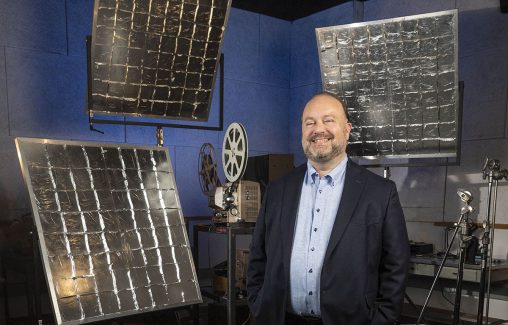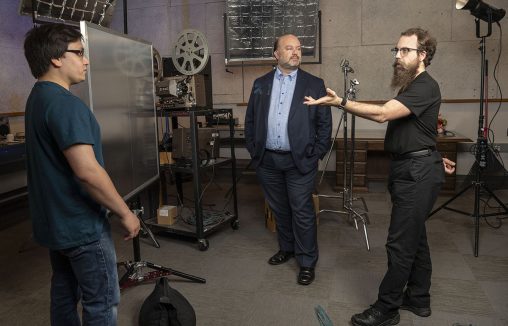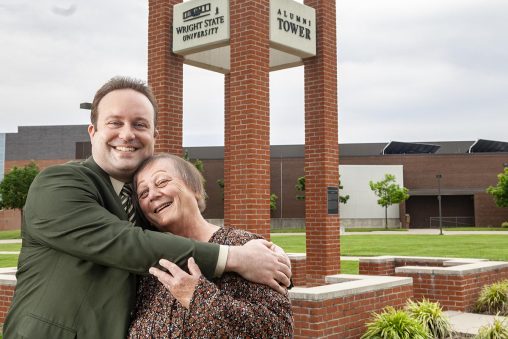
Wright State graduate Mark Black, a financial planner and independent film fan, gives back and helps motion picture students achieve their dreams.
By Anthony Shoemaker ’98
Mark Black wanted to make movies before he attended Wright State University in the early 1990s.
An independent film fan who likes “quirky dramas,” Black admires the work of independent filmmakers such as Blue Velvet’s David Lynch and Out of Sight and Traffic director Steven Soderbergh.
“I was interested in editing, directing, and writing,” Black said. “As the time came for me to go the college path I talked about wanting to go to film school to continue my interest in entertainment. I originally was wanting to go into the motion pictures department.”
Black’s parents were not sure a bachelor’s degree in motion pictures was the best choice for a stable career. His parents said they would help him pay for college, but he would need to pursue his film interest as a hobby and maybe get back into it after graduation.
Instead, Black’s parents wanted him to focus on his business and investment interests. His father Merlin, who worked at Dayton Power & Light (now AES Ohio), introduced him to investments and financial markets as a teenager and helped him chart his career path in business.
Black graduated summa cum laude from the Raj Soin College of Business in 1994 with a B.S. in financial services. A successful local financial planner, he never stopped loving film or Wright State and has made several donations to the university over the years. His most recent donation in December was to the motion pictures program to provide much-needed equipment for new filmmakers.
“I’ve been a supporter of the university since I graduated. I’ve donated my time and money. Things have just come to a point where I wanted to do something specific for the film department as a continuance of my interest in arts and film and entertainment,” said Black, who lives in Beavercreek and grew up in Bellbrook.
After shutdowns from the COVID-19 pandemic and with continuing supply chain issues across the country, Black knew the motion pictures program could likely use some new equipment. “What’s the film school shopping list for equipment that they need?” Black said he asked when considering his donation to the program. “Give me the top five things the film school is seeking and I’ll start there.”
Lighting boards were at the top of the wish list, said Parker Bowling, equipment and facilities manager in the motion pictures program. The school bought four Matthews Studio standard 42×42-inch reflector boards with Black’s donation.
“We didn’t have any of these, it’s a great development in our gear wheelhouse,” Bowling said. “The donations are a wonderful addition to our budget.”
The lighting boards have many uses but are mainly used for filming outside. When there are no outlets for lights or electric generators available, the boards provide a quiet way to make use of sunlight.
“They have a really reflective side on both with a special kind of foil that really does a good job of pushing light back on what you’re aiming it at,” Bowling said.

Mark Black recently visited Wright State’s Tom Hanks Center for Motion Pictures to discuss the new lighting boards purchased with his donation.
The boards are manufactured with tempered glass mirrors. They are made of honeycomb material placed between two sheets of aircraft aluminum.
Bowling said the classic 1950 Japanese film Rashomon by Akira Kurosawa was one of first movies to use a similar lighting technique with a large mirror to get sunlight on actors’ faces when they were under trees. Cinematographer Kazuo Miyagawa used a mirror to reflect the sun’s natural light on actors hidden in the shadows. Bowling said the new lighting boards are a modern development of that classic technique.
The Matthews brand lighting boards are available for students to check out and use in their film productions. Bowling says a lot of students will take advantage of the new equipment because, prior to having the new lighting boards, the program had little to no exterior lighting capabilities. The closest thing the program had for students to use were bounce boards, which were recycled posters from Wright State’s theatre program.
“We have started using the new ones. They are many times more powerful than anything else comparable we have had,” Bowling said. “It’s a very versatile piece of equipment.”
The motion picture programs that will benefit most from the new lighting boards include junior documentary, narrative, and senior thesis works. Black wanted his donation to be for something to “satisfy a gap with something that they could use right off the bat,” he said.
Motion pictures student Mason Perry, who plans to graduate next year, used the new lighting boards last semester during a film shoot in Dayton.
“The reflectors have really been helpful on sets. While you are dependent on the sun showing itself, they let you harness the power of it,” Perry said. “They provide light quality equivalent to a bigger light but with no electric. This also allows us to get light without using generators, which provide noise. So, all in all, it makes for a quieter and more efficient exterior shoot that’s quicker and easier to set up.”
The boards can also work in conjunction with high-powered lights and an overhead frame to give film students more control over their image.
Black recently visited the film school to see the new lighting boards purchased with his donation. His last visit to the school was when it was rebranded the Tom Hanks Center for Motion Pictures in 2016.
Since graduating from Wright State, Black has worked as a certified financial planner and, in 2009, started his own financial planning firm, Vantage Point Financial Services, based in Centerville.
Wright State “set the stage for personal and professional successes,” Black said. In addition to his degree, Black also met his wife, Lori, through the university.
“It’s a double benefit to Wright State. Successful career, successful marriage,” Black said.

Mark Black, pictured with his mother, Judith, who graduated from Wright State with an education degree in 1970. She was Wright State’s first basketball cheerleading adviser.
They have two children: Caitlin is a nurse in Lexington, Ky., and Adam works with his dad at Vantage Point.
Black credits his love for Wright State to his mother, Judith. She graduated from the university with an education degree in 1970 and was Wright State’s first basketball cheerleading adviser. “She was always at dinner talking about Wright State. Wright State this, Wright State that. It just kind of fit in since I was planning to stay in the community to go to college,” Black said.
In addition to his financial support of the university, Black previously served on the Wright State Alumni Association Board of Directors.
Wright State, Black said, “is a gem to have in the community. It’s a great resource to have.”
To support our students in motion pictures, please visit wright.edu/give/mopixfund.
This article was originally published in the fall 2023 issue of the Wright State Magazine. Read more stories at wright.edu/magazine.

 Wright State alum Lindsay Aitchison fulfills childhood space-agency dream
Wright State alum Lindsay Aitchison fulfills childhood space-agency dream  Wright State business professor, alumnus honored by regional technology organizations
Wright State business professor, alumnus honored by regional technology organizations  Wright State University Foundation awards 11 Students First Fund projects
Wright State University Foundation awards 11 Students First Fund projects  Gov. DeWine reappoints Board Treasurer Beth Ferris and names student Ella Vaught to Wright State Board of Trustees
Gov. DeWine reappoints Board Treasurer Beth Ferris and names student Ella Vaught to Wright State Board of Trustees  Joe Gruenberg’s 40-Year support for Wright State celebrated with Honorary Alumnus Award
Joe Gruenberg’s 40-Year support for Wright State celebrated with Honorary Alumnus Award 